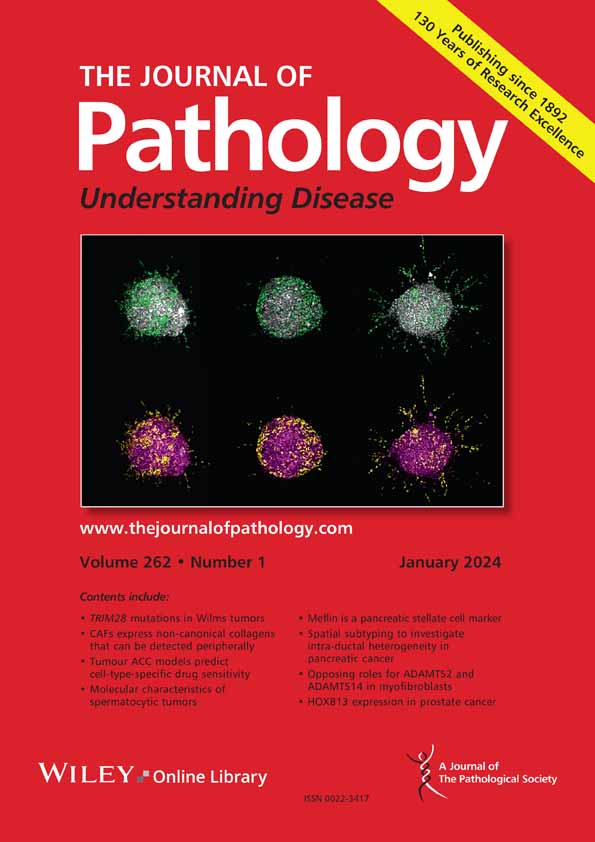Mengjie Yu, Dou Yang, Danxia Zhu, Yue Wang, Minmin Cao, Jingfeng Zhu, Wei Zhu, Guangji Wang, Jiye Aa
求助PDF
{"title":"Circulating metabolomics reveals guanosine monophosphate synthetase (GMPS) as a novel therapeutic target in lung adenocarcinoma","authors":"Mengjie Yu, Dou Yang, Danxia Zhu, Yue Wang, Minmin Cao, Jingfeng Zhu, Wei Zhu, Guangji Wang, Jiye Aa","doi":"10.1002/path.6442","DOIUrl":null,"url":null,"abstract":"<p>Metabolic reprogramming is pivotal in the initiation and progression of lung adenocarcinoma (LUAD). However, a substantial gap remains in the understanding of the primary drivers of metabolic reprogramming and alterations in early-stage LUAD. Using an unbiased, large-scale metabolomics analysis of 2,531 plasma and serum samples from three independent clinical centers, we identified significant perturbations in purine metabolism that characterized reprogrammed metabolism in early-stage LUAD. Additionally, hypoxanthine (<i>p</i> < 0.001) and xanthine (<i>p</i> < 0.05) were identified as two typical early risk indicators, with odd ratios (ORs) more than 2.8 and 1.45, respectively. Guanosine monophosphate synthetase (GMPS) was identified as a pivotal factor in the early development and malignant progression of LUAD. Progression of LUAD was significantly attenuated by <i>GMPS</i> knockdown and markedly exacerbated by its overexpression. Further data indicated that GMPS primarily contributed to the reprogrammed metabolic phenotypes of LUAD through its enzymatic activity and subsequent production of purine nucleotides, based on the relative abundance of the labeled isotope metabolites. Collectively, dysregulated purine metabolism emerged as a key characteristic of early-stage LUAD, and targeting GMPS activity may offer a promising therapeutic potential for LUAD treatment. © 2025 The Pathological Society of Great Britain and Ireland.</p>","PeriodicalId":232,"journal":{"name":"The Journal of Pathology","volume":"266 4-5","pages":"465-480"},"PeriodicalIF":5.2000,"publicationDate":"2025-06-20","publicationTypes":"Journal Article","fieldsOfStudy":null,"isOpenAccess":false,"openAccessPdf":"","citationCount":"0","resultStr":null,"platform":"Semanticscholar","paperid":null,"PeriodicalName":"The Journal of Pathology","FirstCategoryId":"3","ListUrlMain":"https://pathsocjournals.onlinelibrary.wiley.com/doi/10.1002/path.6442","RegionNum":2,"RegionCategory":"医学","ArticlePicture":[],"TitleCN":null,"AbstractTextCN":null,"PMCID":null,"EPubDate":"","PubModel":"","JCR":"Q1","JCRName":"ONCOLOGY","Score":null,"Total":0}
引用次数: 0
引用
批量引用
Abstract
Metabolic reprogramming is pivotal in the initiation and progression of lung adenocarcinoma (LUAD). However, a substantial gap remains in the understanding of the primary drivers of metabolic reprogramming and alterations in early-stage LUAD. Using an unbiased, large-scale metabolomics analysis of 2,531 plasma and serum samples from three independent clinical centers, we identified significant perturbations in purine metabolism that characterized reprogrammed metabolism in early-stage LUAD. Additionally, hypoxanthine (p < 0.001) and xanthine (p < 0.05) were identified as two typical early risk indicators, with odd ratios (ORs) more than 2.8 and 1.45, respectively. Guanosine monophosphate synthetase (GMPS) was identified as a pivotal factor in the early development and malignant progression of LUAD. Progression of LUAD was significantly attenuated by GMPS knockdown and markedly exacerbated by its overexpression. Further data indicated that GMPS primarily contributed to the reprogrammed metabolic phenotypes of LUAD through its enzymatic activity and subsequent production of purine nucleotides, based on the relative abundance of the labeled isotope metabolites. Collectively, dysregulated purine metabolism emerged as a key characteristic of early-stage LUAD, and targeting GMPS activity may offer a promising therapeutic potential for LUAD treatment. © 2025 The Pathological Society of Great Britain and Ireland.
循环代谢组学揭示了鸟苷单磷酸合成酶(GMPS)是肺腺癌的一个新的治疗靶点。
代谢重编程在肺腺癌(LUAD)的发生和发展中起着关键作用。然而,对于早期LUAD中代谢重编程和改变的主要驱动因素的理解仍然存在很大的差距。通过对来自三个独立临床中心的2531份血浆和血清样本进行无偏倚的大规模代谢组学分析,我们发现了嘌呤代谢的显著扰动,这是早期LUAD重编程代谢的特征。此外,次黄嘌呤(p
本文章由计算机程序翻译,如有差异,请以英文原文为准。



 求助内容:
求助内容: 应助结果提醒方式:
应助结果提醒方式:


